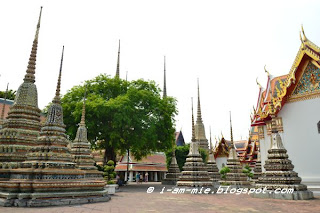Wat Pho (the Temple of the Reclining Buddha), or Wat Phra Chetuphon, is located directly adjacent to the Grand Palace ,behind the Temple of the Emerald Buddha.The temple, also known as the birthplace of traditional Thai massage, named after a monastery in India where Buddha is believed to have lived.
The image of reclining Buddha is 15 m high and 43 m long with his right arm supporting the head with tight curls on two box-pillows of blue, richly encrusted with glass mosaics.
The 3 m high and 4.5 m long foot of Buddha displays are inlaid with mother-of-pearl. They are divided into 108 arranged panels, displaying the auspicious symbols by which Buddha can be identified like flowers, dancers, white elephants, tigers and altar accessories.
The Buddha's feet are 3 metres long and exquisitely decorated in mother-of-pearl illustrations of auspicious 'laksanas' (characteristics) of the Buddha.
There are 108 bronze bowls in the corridor indicating the 108 auspicious characters of Buddha. People drop coins in these bowls as it is believed to bring good fortune, and to help the monks maintain the wat.
The Wat Pho complex consists of two walled compounds bisected by Soi Chetuphon running east–west.
The northern walled compound is where the reclining Buddha and massage school are found.
The southern walled compound, Tukgawee, is a working Buddhist monastery with monks in residence and a school.
Outside the temple, the grounds contain 91 chedis (stupas or mounds), four viharas (halls) and a bot (central shrine). 71 chedis of smaller size contains the ashes of the royal family, and 21 large ones contain the ashes of Buddha.The four chedis are dedicated to the four Chakri kings.
The temple has sixteen gates around the complex guarded by Chinese giants carved out of rocks.These statues were originally imported as ballast on ship trading with China.
The main temple is raised in marble platform punctuated by mythological lions in the gateways. The exterior balustrade has around 150 depictions of the epic, Ramakien, the ultimate message of which is transedence from secular to spiritual dimensions.
The outer cloister has images of 400 Buddhas out of the 1200 originally bought by king Rama V. In terms of architecture, these are varied in different styles and postures, but these are evenly mounted on matching gilded pedestals.

























No comments:
Post a Comment
Please share your thoughts...